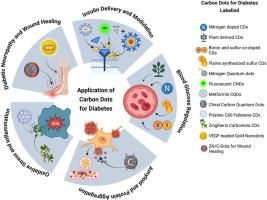A Systematic Review of the Applications of Carbon Dots for the Treatment of Diabetes
IF 4.9
3区 医学
Q1 PHARMACOLOGY & PHARMACY
Journal of Drug Delivery Science and Technology
Pub Date : 2025-09-06
DOI:10.1016/j.jddst.2025.107497
引用次数: 0
Abstract
Diabetes mellitus is a chronic disease which is defined by persistent hyperglycemia and long-term complications which include neuropathy, nephropathy, and impaired wound healing. Conventional therapies face limitations like side effects, poor drug bioavailability, and invasive monitoring methods. This systematic review examines the recent studies that have been done for the use and administration of carbon dots (CDs), that are small biocompatible nanomaterials for diabetes treatment and diagnosis. Drawing from in vitro and in vivo studies, we highlight the nitrogen-doped CDs for α-glucosidase inhibition, plant-derived CDs for glucose regulation, sulfur and boron/sulfur-doped CDs for non-enzymatic glucose sensing, nitrogen-doped and metformin-derived CDs for insulin delivery, chiral CDs for amyloid aggregation control, Arg CDs and pristine C60 fullerenes for antioxidant and anti-inflammatory activity, Zingiberis-based CDs for hepatoprotection, Zn/C-dots and VEGF-loaded nanodots for wound repair and nerve regeneration and glucose-derived CDs for blood-brain barrier penetration. These functionalized systems use heteroatom doping and surface engineering to combine therapeutic and diagnostic potential, protect β-cells, improve medication absorption, and allow non-invasive glucose monitoring. Notably, several nanodots originally developed for unrelated biomedical purposes have also shown properties beneficial for diabetes management, showing opportunities for repurposing, though further validation in diabetic models is required. While CDs show promise as an integrated platform for managing diabetes and its complications, critical challenges remain in achieving scalable, reproducible synthesis, ensuring long-term safety, and optimizing targeted biodistribution. Future work should prioritize standardized production, mechanistic studies and extended preclinical and clinical evaluation to facilitate translation into effective, patient-friendly nanotherapeutics.

碳点在糖尿病治疗中的应用综述
糖尿病是一种慢性疾病,以持续高血糖和包括神经病变、肾病和伤口愈合受损在内的长期并发症为特征。传统疗法面临副作用、药物生物利用度差和侵入性监测方法等局限性。本系统综述审查了最近关于碳点(cd)的使用和管理的研究,这是一种用于糖尿病治疗和诊断的小型生物相容性纳米材料。根据体外和体内研究,我们重点介绍了氮掺杂CDs对α-葡萄糖苷酶的抑制作用,植物源CDs对葡萄糖的调节作用,硫和硼/硫掺杂CDs对非酶促葡萄糖的传感作用,氮掺杂CDs和二甲双胍衍生CDs对胰岛素的递送作用,手性CDs对淀粉样蛋白聚集的控制作用,精氨酸CDs和原始C60 fullerenes具有抗氧化和抗炎活性,基于姜黄草的CDs具有肝保护作用,Zn/ c -dot和vegf负载纳米点用于伤口修复和神经再生,葡萄糖来源的cd用于血脑屏障穿透。这些功能化系统使用杂原子掺杂和表面工程来结合治疗和诊断潜力,保护β细胞,改善药物吸收,并允许无创血糖监测。值得注意的是,最初为不相关的生物医学目的开发的几种纳米点也显示出对糖尿病管理有益的特性,显示出重新利用的机会,尽管需要在糖尿病模型中进一步验证。虽然CDs有望成为管理糖尿病及其并发症的综合平台,但在实现可扩展、可重复的合成、确保长期安全性和优化靶向生物分布方面仍存在重大挑战。未来的工作应优先考虑标准化生产、机制研究和扩展临床前和临床评估,以促进转化为有效的、对患者友好的纳米疗法。
本文章由计算机程序翻译,如有差异,请以英文原文为准。
求助全文
约1分钟内获得全文
求助全文
来源期刊
CiteScore
8.00
自引率
8.00%
发文量
879
审稿时长
94 days
期刊介绍:
The Journal of Drug Delivery Science and Technology is an international journal devoted to drug delivery and pharmaceutical technology. The journal covers all innovative aspects of all pharmaceutical dosage forms and the most advanced research on controlled release, bioavailability and drug absorption, nanomedicines, gene delivery, tissue engineering, etc. Hot topics, related to manufacturing processes and quality control, are also welcomed.

 求助内容:
求助内容: 应助结果提醒方式:
应助结果提醒方式:


